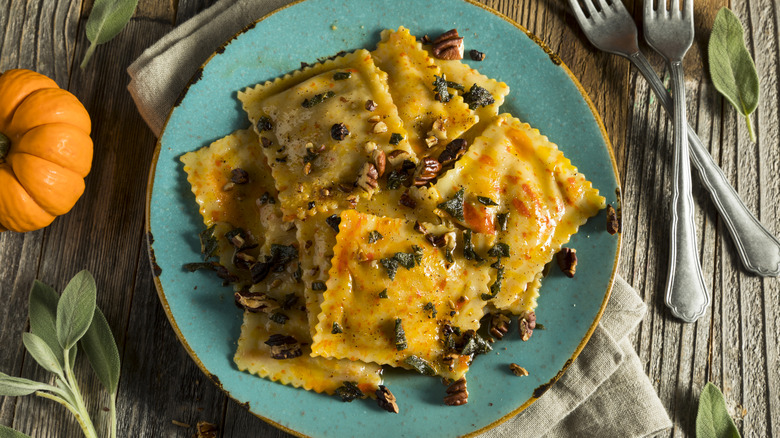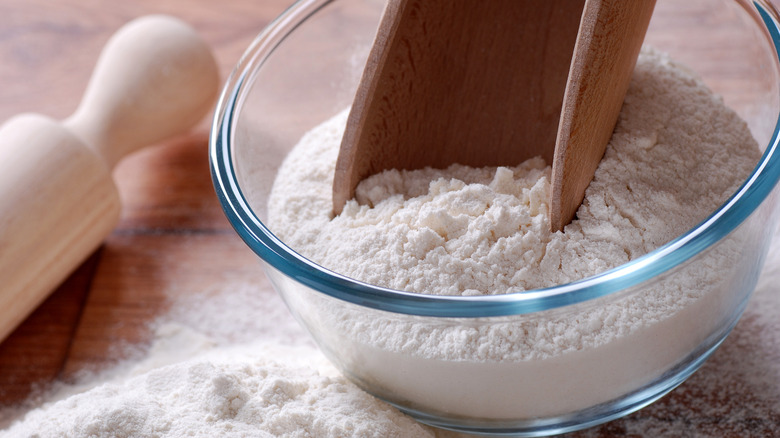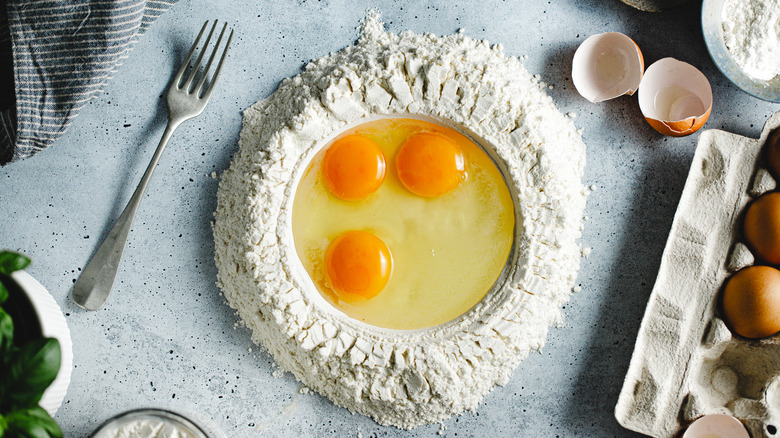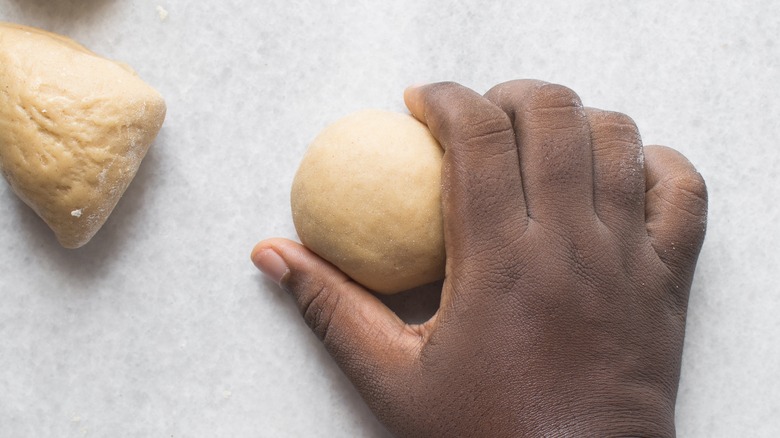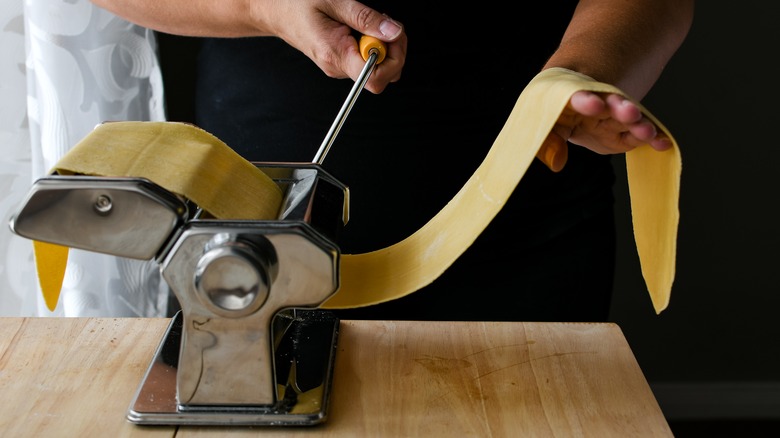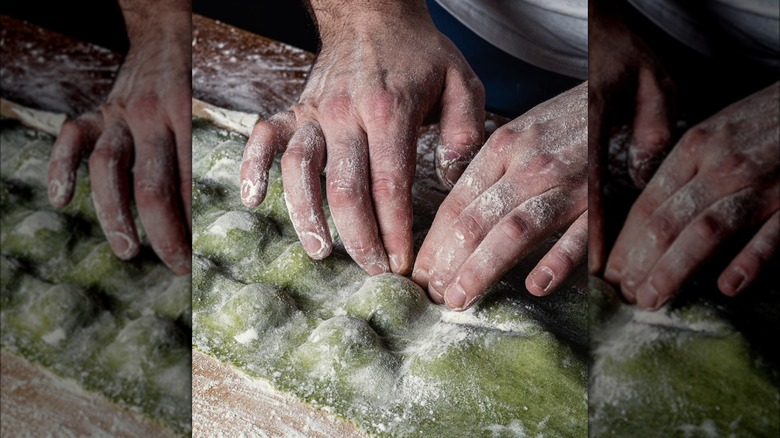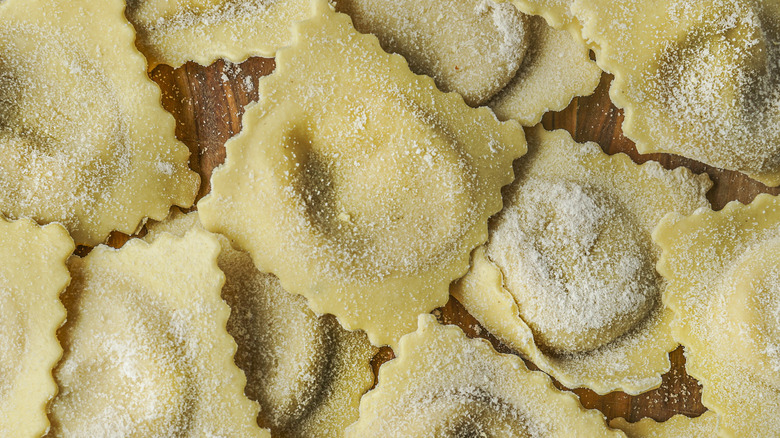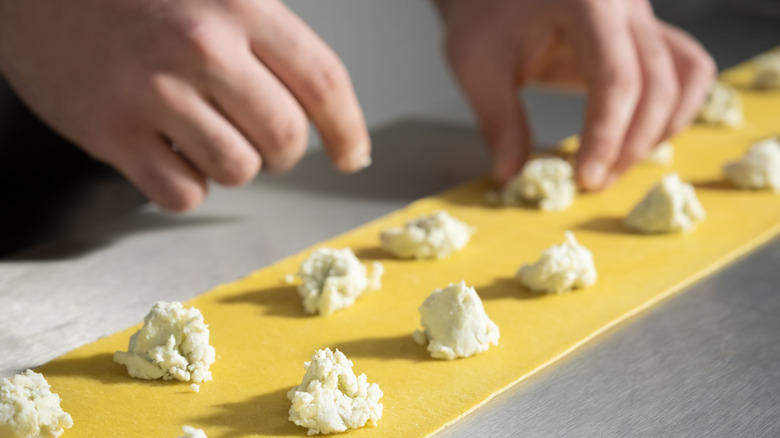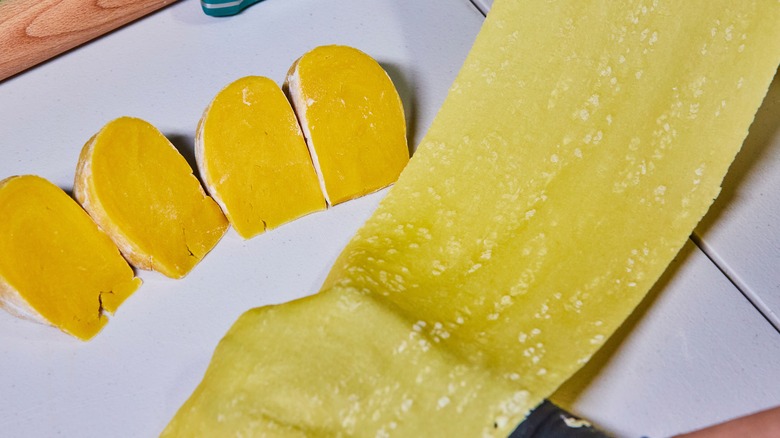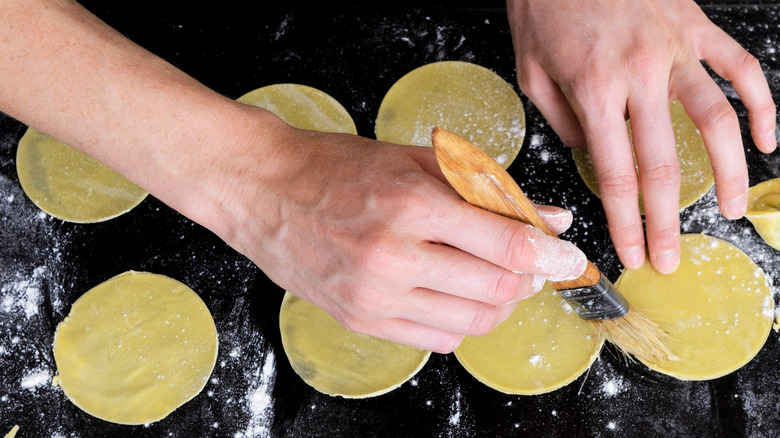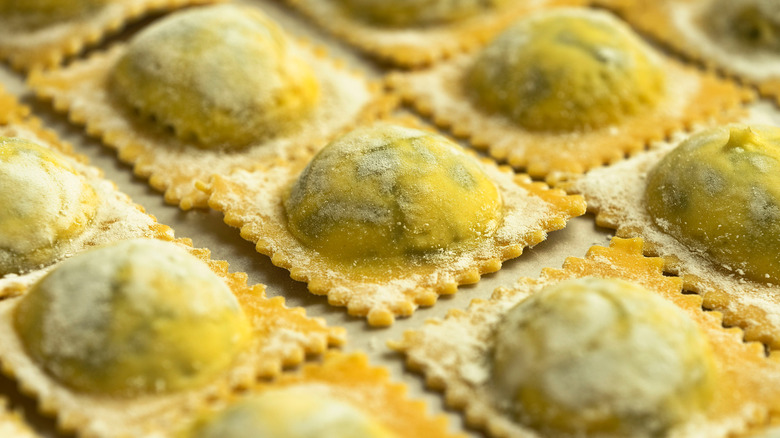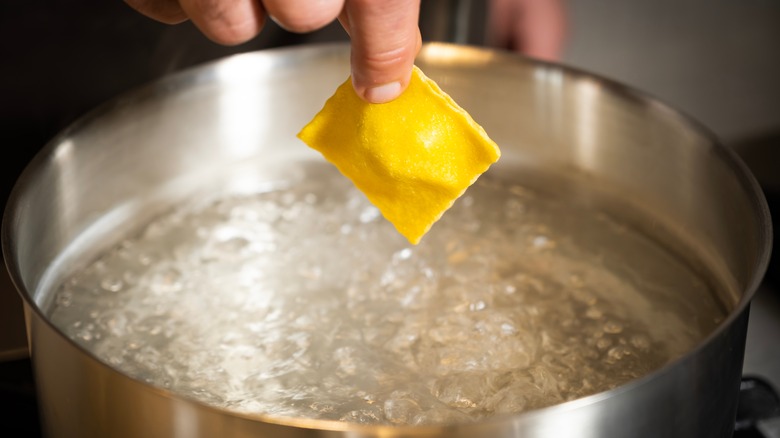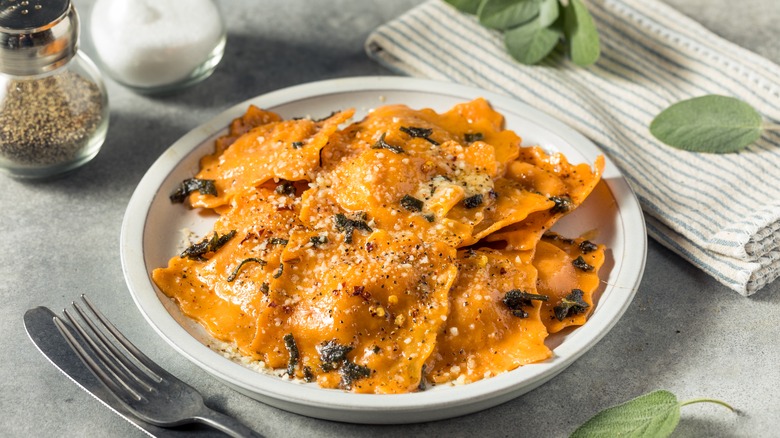Mistakes Pros Never Make With Homemade Ravioli
You've had some amazing handmade ravioli at restaurants and it's made you swear off the packaged stuff, so you try making it yourself. But, your homemade ravioli never turns out quite the way you want it to — what gives? Although the process isn't quite as daunting as it can seem, there are still plenty of mistakes that people can make with homemade ravioli. These mistakes can lead to issues such as stodgy pasta or ravioli that comes unstuck during cooking, causing the filling to spill out.
Understanding the potential errors is key to understanding what went wrong with your failed ravioli attempt. Or, if you're new to making stuffed pasta, it could help you get perfect results the first time around. We talked to four experts — three chefs and a blogger specializing in Italian food — about the biggest pitfalls to avoid. They've put in the hours and made all these missteps in the past so that you don't have to. Keep reading to discover the mistakes pros never make with homemade ravioli and what you should do instead. Your stuffed pasta game is about to get 100 times better.
Using the wrong type of flour
There are many mistakes you can make with fresh pasta. If your dough is too tough when cooked, is hard to work, or won't come together, it's possible that you're using the wrong type of flour. "The flour used makes an enormous difference," says chef Max Crask of St. Louis Italian-American restaurant Madrina. He explains, "00 pasta flour has a lower gluten level than most other flours, this includes 00 pizza flour, which makes it much easier to work with and shape."
But, that's not the only option for making your dough. At chef Wyatt Piazza's Philadelphia restaurant Kiddo, they use a mix of semolina flour and 00 flour. According to Piazza, the 00 flour is very fine and soft, while the semolina has a coarser grind and is made from a harder wheat. "We use a balance of both to ensure that the pasta has the correct texture for the shape," he notes. "The semolina helps give the ravioli a little bit of backbone, so I use a smaller amount to ensure a softer, more pillowy dough." Crask also mentions using semolina flour to make eggless pasta for ravioli, which is great for vegans or anyone with an egg allergy.
Sticking too rigidly to an exact dough recipe
If you're the kind of person who follows recipes to the letter, this is where you might be going wrong making dough for your ravioli. It seems like following a recipe exactly would be a good thing, but there are many variables when it comes to making pasta, so sometimes you need to make adjustments depending on the consistency of the dough.
"We do not measure all of the ingredients at the restaurant because it can be hard to account for other factors such as humidity, hydration, temperature, and more," says chef Wyatt Piazza. He notes that they start with the same weight of flour and one whole egg, before adding egg yolks as they mix the dough. This lets them have more control over the hydration. "We are looking to achieve a dry dough that just comes together and can be kneaded into a smooth ball," he explains.
Chef Max Crask agrees that measuring isn't always the best option when making pasta dough for ravioli. "I remember when I was just starting out, making pasta exactly measured to the recipes I had and it was entirely wrong," he recalls. When making dough, he notes that "the pro tip here is to err on the side of too wet — it's much easier to work in more flour than to try to get a dry ball to absorb an egg."
Rolling out the dough immediately after making it
Struggling to get your dough to roll out thin enough? This might be because you're attempting to roll it out (whether by hand or in a pasta machine) right after you make it. This is a mistake. According to Wyatt Piazza, chef and owner of Kiddo, you should "let the dough rest for 20 to 30 minutes before sheeting." For those not in-the-know, sheeting is the culinary term for rolling pasta out into sheets. Piazza explains that this resting period "gives time for the gluten to relax and makes it easier to work with."
Letting the dough rest also makes sure that it's fully, evenly hydrated. This means that all the eggs (or other liquid, if you're making egg-free pasta) has been absorbed by the flour molecules. This not only helps with rolling but improves the overall texture. So, don't be tempted to skip the resting step. Making ravioli from scratch is a time-consuming process, anyway, so what's an extra 30 minutes? Give yourself a leisurely amount of time for this project and don't rush it. Your ravioli will be better for it.
Making the dough too thin or too thick
Another frequent mistake people make is producing dough that is too thin or too thick. It's actually more common for newbies to the ravioli game to make the dough overly thick, but thin, fragile dough is an issue, too. When your dough is too thick, your stuffed pasta won't have a delicate enough texture. But, if it's too thin, it might tear and not hold the filling in.
"As ravioli involves folding one sheet of pasta over another, the dough effectively doubles in thickness," chef Bill Dorrler of Osteria Morini in Washington, D.C., points out. "If not handled properly, this can result in ravioli that is too thick and chewy, rather than achieving the desired delicate and tender texture." When will you know the dough's thin enough? "A good rule of thumb is that you should be able to see your hand through the sheet of pasta when you hold it up to the light," Dorrler notes.
Food blogger Liz Krause at Simple Italian Cooking has a straightforward piece of advice for getting your dough the right thickness: "Use a pasta machine." She says that ravioli dough should be thin, so hand rolling is hard work. "If using a hand held/crank machine, continue rolling until you get close to the last roller setting, so either a six or seven," she suggests. She notes that this is thick enough to stop the dough tearing, but not so thick that it ruins the texture.
Not pushing the air out around the filling
When you fill ravioli the traditional way, you lay down one sheet of pasta, spoon the filling onto it in little piles, then top the whole lot with another sheet. Then, you seal each around the filling and cut them into ravioli shaped squares or rectangles with a pasta cutter. It's fairly straightforward over all. However, there's a common mistake people make — not pushing the air out around the filling before sealing it.
Not only can this give you unsightly puffy pieces of stuffed pasta, but it can also lead to the filling blowing out when you cook them. "Leaving air pockets will cause all sorts of problems," says Max Crask, chef at Madrina. "Aside from just falling apart, the air will try to escape, filling the inside with pasta water."
Air in your ravioli can lead to disaster, but it's easy to avoid once you know it's an issue. "Once the top sheet is in place, it's crucial to push out all the air around the filling," says chef Bill Dorrler. "Use the sides of your thumbs or index fingers to press the pasta, creating a tight, parcel-like appearance around the filling."
Overstuffing or underfilling the ravioli
It's possible to put either too much or too little filling in your ravioli, so you have to get the right balance. "The danger of under-stuffing ravioli is that more air can get in, whereas the danger of overstuffing is that the edges of the ravioli might not seal properly," says chef Wyatt Piazza.
As mentioned above, the trouble with getting air bubbles in your stuffed pasta is that it can expand and rupture the seal during cooking, which leads to the filling leaking out. But, overfilling your ravioli can also cause the sealed edges to break, losing your filling to the cooking water — so it's a lose-lose situation. That's why it's important to judge it correctly. Food blogger Liz Krause suggests you "don't overstuff with items that are too heavy for the ravioli, such as too much sausage," as this makes blowouts even more of a possibility.
But, chef Max Crask says that it's easy to tell if your ravioli will hold up or not. "Always do a test ravioli before you stuff all of them just to have the entire batch blow apart in the water," he suggests. "As long as you have enough room to get a good seal you should be in good shape." Piazza also notes that using spring-loaded stamps to make ravioli prevents the chance of overfilling, as they only hold so much.
Using too wet a filling
Stuffing your ravioli with something overly moist can be an issue, so it's important to think about the filling before you go ahead and dump it in. "If the filling is too wet you will find that it ruins the ravioli," Max Crask explains. It can turn the dough soggy, either messing up the texture or completely causing the ravioli to fall apart, either before or during cooking.
But, Crask notes that it's particularly a problem if you're going to cook them some hours after you've made them. "If you cook them immediately, you can probably get away with that one," he adds. Egg raviolo is proof that you can get away with a wet filling — and this is one of the dishes Crask himself recommends ordering at an Italian restaurant. It's a large ravioli filled with an egg yolk, and you don't get much more gloppy than that. But, naturally, this isn't the type of dish you should attempt making as a beginner with stuffed pasta — stick to something drier and make your life easier.
So, what makes a good ravioli filling? There are all kinds of things you can experiment with. Pumpkin ravioli is a popular choice, as are those stuffed with mushrooms and various cheeses. Cheese is great, but there are many stuffed pasta fillings that aren't just cheese. You might try something more unusual, like pea and mint, or add an unexpected element, such as fig jam.
Letting the dough dry out
Letting the pasta dough dry out before you've filled it can lead to serious issues. "Having dry dough before filling is a problem because it prevents the ravioli from sealing," says Wyatt Piazza. And, if your ravioli doesn't seal properly, they're likely to fall apart when cooking. Piazza also notes that dry dough can tear on top when filled due to a loss of elasticity in the dough, meaning it can't stretch over the filling without cracking. "When stuffing the pasta, keep the top pasta sheet folded and wrapped in plastic or covered with a cloth to ensure the top layer doesn't dry out," he suggests.
If your pasta dries out, it isn't the end of the world. "Pasta is a very forgiving medium however, so you can always bring it back by simply covering the sheets with plastic wrap tightly and walking away for half an hour," says Max Crask. "You'll find that the pasta has rehydrated itself." Crask also suggests using a spray bottle to help rehydrate dried dough, especially when sealing it, while Piazza says this works but it isn't a method he likes to use.
Not sealing ravioli correctly
It's vital to seal your ravioli properly, otherwise it won't stay together when you cook it. Instead of delicious stuffed pasta, you'll be left with flat pasta squares and a murky pot of cooking water with bits of filling floating in it. So, learning how to get a good seal is an important part of learning to make ravioli. You can't just hope for the best.
"To ensure a proper seal for your ravioli, use a small amount of water as glue between the bottom and top sheets of pasta," says Bill Dorrler "You can do this by wetting your finger and running it along the edge of the pasta, or by using a spray bottle set to mist for gentle application." Max Crask also notes the importance of a good seal: "You want a fairly wet dough to start with so that it will seal," he explains. "A spray bottle of water can be deployed to help glue everything together."
According to Liz Krause, a poor seal "can be caused by overstuffing the ravioli which puts too much pressure on the seal itself, or it can be caused by not properly creating a good seal with the pasta dough." She suggests pressing the top and bottom sheets together extra firmly when sealing to adhere the pieces properly.
Letting the ravioli stick to surfaces before cooking
Disaster can strike once you've made the ravioli and you're waiting until it's time to cook it. Maybe you're waiting for the pot to boil or you're making another batch before you start cooking. A big mistake that many people make is letting the ravioli stick to surfaces — or each other — while it's hanging around.
"The hardest part, and one of the most common mistakes, is properly storing the ravioli when it is done," says chef Wyatt Piazza. "You want to ensure it remains fresh, and you do not want it to stick to itself and form one large mass. A trick is to put a lot of semolina on a tray before laying the ravioli and keep the ravioli spread out at all times."
Don't put the pieces on a surface without semolina to keep them from sticking and don't pile the ravioli up, so that they all adhere to one another. This is a surefire route to messy, misshapen ravioli, at best. They might even stick so thoroughly that you tear the dough and the filling comes out.
Boiling ravioli too vigorously
When you cook pasta, it's often at a rolling boil, so you might expect to cook homemade ravioli this way, too. However, it's not the same as the packaged stuff. Of course, you could just upgrade your store-bought ravioli, but it's really not the same as stuffed pasta made from scratch. So, it's important to learn how to cook it properly.
"For homemade ravioli you're dealing with a lighter texture and more delicate dough than store bought," says food blogger, Liz Krause. "So, make sure to cook them in a very gentle boil or even a simmer so that they can cook without too much movement." This helps to keep them in one piece while they cook, rather than falling apart from the force of the water. It also prevents them from getting overcooked and rubbery. So, keep that boil gentle rather than instinctively turning your stovetop up as high as it will go.
Undercooking ravioli
You might have made your ravioli perfectly, but if you don't cook it correctly, you're falling at the final hurdle. Undercooking ravioli is a common mistake. "Using an improper water-to-pasta ratio or not bringing the water to a full boil can result in undercooked, raw-tasting pasta," says chef Bill Dorrler. Yes, boiling your ravioli too vigorously can be a problem, but not bringing the water to a full boil can lead to undercooked pasta, too, so you've got to find that balance.
As well as making sure your water is boiling before adding your ravioli, Dorrler also suggests considering cooking in batches, especially if you're making a lot. "Depending on the quantity of pasta, it's better to cook in batches to avoid overcrowding the pot," he says. "This ensures the water remains at a full boil, which is crucial for proper cooking."
Undercooked ravioli can be gooey and taste of flour, so it's certainly something you want to avoid. Generally, you can tell they're done when they float to the surface and feel firm to the touch — which should be after about four to five minutes. And, when they're done, it's a mistake to drain ravioli with a colander. This can cause them to break up. Instead, use a serving spoon or slotted spoon to lift them out of the water.
